One of the highlights of any birding trip to Florida’s Space Coast is watching waders and waterfowl at Ritch Grissom Memorial Wetlands at Viera, better known as the Viera Wetlands. These wetlands, part of the Great Florida Birding Trail, are a model of sustainable land use. Considered an integral component of Brevard County’s water reuse system, the artifical wetland system polishes reclaimed water for irrigation or overflow into the adjacent canal while creating a biologically diverse ecosystem accessible to the public. Birders love Viera Wetlands not just for the birds, but also the thoughtful touches like an auto loop connecting cells of various depths with observation decks overlooking the large lake.
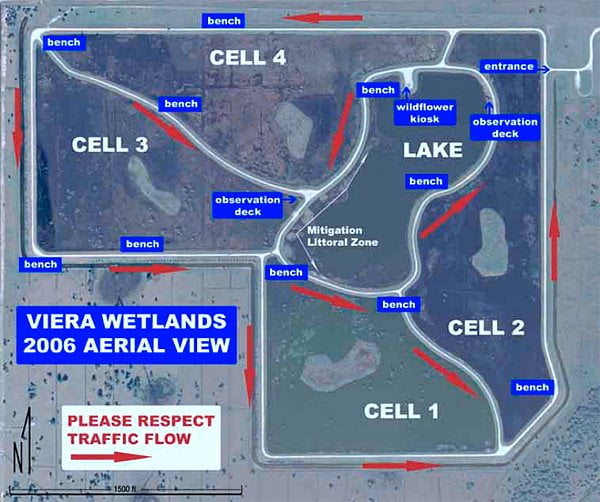
And how about those birds? The checklist reads like a who’s-who of Florida avian celebrities, including highly coveted vagrants like 2010’s Masked Duck. My mission was to find out what was so special about Viera Wetlands. Luckily, the success of this venture was assured the moment I realized that my guides were none other than Jeff Gordon of the ABA and Mike Freiberg of Nikon. Having Jan Pierson of FieldGuides along didn’t hurt either! Let the action begin…
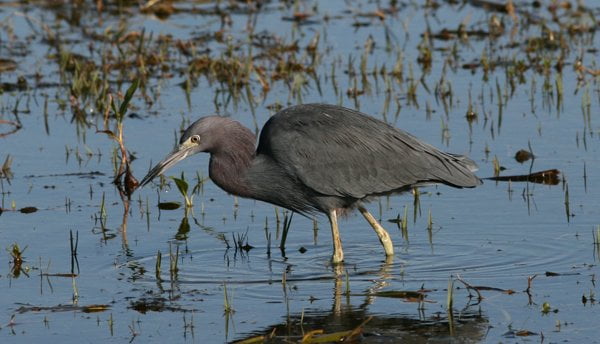 Little Blue Heron
Little Blue Heron
Emphasizing waterfowl may seem unfair when crackers like Crested Caracara, Sandhill Crane, Wood Stork, and Limpkin make the scene but ducks, rallids, and long-legged waders really do steal the show in such a habitat. Crowds of coots and moorhens made up a substantial percentage of the birds in the ponds. The most common ducks were Athaya species, particularly Lesser Scaup and Ring-necked Ducks. Displaying Hooded Mergansers demanded attention, though as a northeasterner I was more thrilled to spy the subtle charms of the Mottled Duck, a member of the maddening mallard complex.
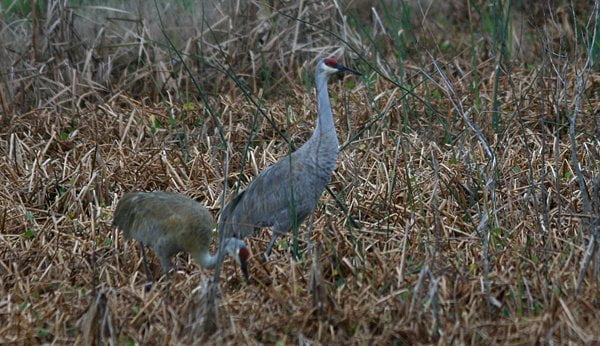 Sandhill Cranes
Sandhill Cranes
The birds of Viera Wetlands tend to be the ones you’d expect. All of the usual Florida herons and egrets turn up, as do scads of Anhinga, Double-crested Cormorant, and both White and Glossy Ibis. My favorite bird was not one I expected but rather hoped for. After all, how often can you count on a bittern? Thanks to a combination of perceptiveness, persistence, and teamwork bolstered by expensive optics, we all enjoyed fabulous looks at a distant American Bittern prowling in the reeds. Apparently, Viera Wetlands has become somewhat reliable for bitterns, for which it deserves great praise and repute.
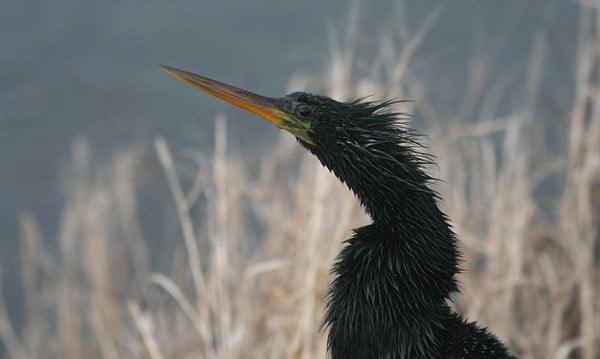 Anhinga
Anhinga
Steadily rising rainfall drained the momentum from our survey of the sewage cells. Nonetheless, we racked up most of the available avifauna. One of our best sightings, occurring at the end of the facility tour, was none other than Julie Zickefoose, who in turn has an awesome Snail Kite sighting that most of our group missed. You really can’t predict what you’ll see at Viera Wetlands!
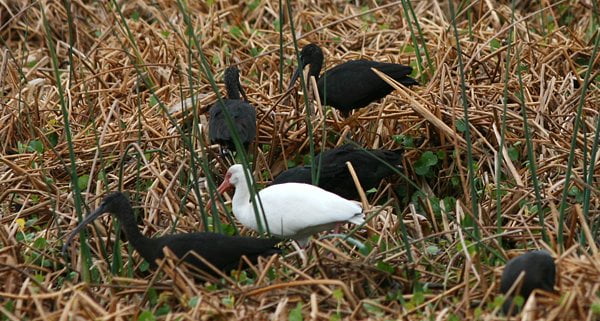 Which of these things is not like the others?
Which of these things is not like the others?
If you want to tour Viera Wetlands in the company of the kind of talented guides I visited with, you can’t go wrong attending the annual Space Coast Birding & Wildlife Festival.
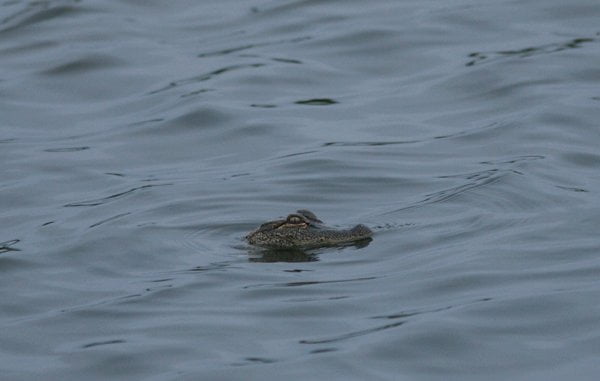 What a cutie! (A baby gator was the highlight of my trip as far as my daughter is concerned.)
What a cutie! (A baby gator was the highlight of my trip as far as my daughter is concerned.)











Funny you should mention it…….we were just there yesterday and I had posted some photos on Facebook (http://www.facebook.com/album.php?aid=2091191&id=1624398280&l=7bd5f89fc3). I’m not a seasoned birder and am just learning the finer details of identification. There were a lot of wonderful birds out at the wetlands last evening, but one in particular I can’t identify that I frequently see there. It is a duck of some sort, black and white, with a big ruff over the top of its head. The best I could match was a hooded merganser, but from my vantage point it doesn’t appear to have any brown on it. It doesn’t come close to the shore, so I’ve not been able to snap a good photo with my camera. Any suggestions?
Nice pics, Martha. Yes, the bird you describe is most certainly Hooded Merganser. That white crest is unmistakable. Winter in the northeast US is a great time to find those birds close to shore and in decent light at local parks and ponds.
No brown? Far from shore? Bufflehead.
See, this is why I’m not a guide; I sometimes rush to judgment! However, I should add that two weeks ago at Viera Hooded Mergs were plentiful and Bufflehead were absent. But you, Martha, should definitely look at Bufflehead because Rick is wise in these matters.
Too bad we didn’t make a meet, Mike. And for the Meerganser. Male Hooded Meerganser are Black and White – females are brown. http://www.flickr.com/photos/lenblumin/2144613152/
Bufflehead would be highly unlikely at Viera.
I can go only from the description. No male Hooded Merganser lacks brown.
Based on Klaus’ photo, I would say it is definitely the Male Hooded Merganser! BTW — beautiful photo! Wish I could get that close…..or had a lens that could. Thanks!
My favorite moment at Viera so far, this bald eagle. Everytime I go I am never disappointed.
Link to Bald Eagle
Glad the mystery’s solved, Martha!
In the wake of my tongue-in-cheek remark to Clare’s recent Tasmania post, I find it quite charming to see the reserve has an “auto loop”. Yes, I know ´cars make good hides, but come on, a ~5 mile hike isn’t too bad? 😉
Thanks to Jochen for explaining the arrows mystery. Agree, 5 miles hike (or ride) does not seem too much, even with a scope on your back.
Thanks Mike for linking the Great Florida Birding Trail web site! I used it and it directed me to one spot where I might be able to get both of my “Central” Florida target species, Crested Caracara and Burrowing Owl, it directed me to Kissimee Prairie State Park, where we found 7 Caracara’s and 2 Burrowing Owls as well as host of more common birds!
If you have never visited Kissimee Prairie State Park it is worth the visit! We only slowly drove along the road from the main road to the ranger station, but there are miles and miles of awesome looking, easy (aka flat!) trails.
I spend a lot of time out at the wetlands both on foot as well as in the vehicle. I have been able to capture some amazing heron and egret images as well as the moorhen. Last week as I was shooting a really nice osprey I had a bald eagle fly right ove my head. He flew through but did not come back. I have noticed an explosion of popularity in the wetlands since the paved road bypassed the ttreatment plant. Great heron seem to be preparing nests. Idk if the weather has then messed up or if they start this early normally